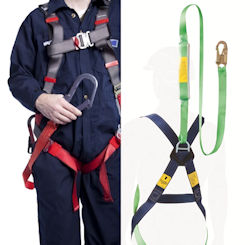Connection Systems: Lanyards
A lanyard is a flexible rope, wire rope, or strap which generally has a connector at each end for connecting the body belt or body harness to a deceleration device, lifeline, or anchorage point.
Some manufacturers offer adjustable length lanyards. Effective lanyards are maintained in a clean, intact condition, and inspected prior to each use for wear, tear, and any obvious distortion or signs that the fall arrest (energy-absorbing) system has been activated
A special type of lanyard, called an "integrated" lanyard only has a snap hook at one end. Lanyards must have a minimum breaking strength of 5,000 pounds. They come in a variety of designs, including self-retracting types that make moving easier and shock-absorbing types that reduce fall-arrest forces. Don't combine lanyards to increase length or knot them to make them shorter.
Deceleration Devices
A deceleration device is a mechanism (e.g., tearing or deforming lanyards) that serves to dissipate energy during a fall to limit the energy and stress imposed on a worker during a fall. Deceleration occurs over a maximum distance of 3.5 feet. Deceleration devices vary widely. Examples include:
- Self-retracting lanyard. A self-retracting lanyard/lifeline contains a drum-wound line which can be slowly extracted or retracted. The lanyard extends as necessary to allow the worker to move about the work area, but retracts as necessary to maintain slight tension, preventing the line from becoming slack. The drum is under slight tension during normal worker movement and automatically locks the drum when the line is extracted too rapidly.
- Self-retracting lanyards and lifelines that limit free fall to two feet or less need to sustain, at a minimum, 3,000 pounds applied to the device with the lanyard in the fully extended position.
- Self-retracting lanyards that do not limit free fall to two feet or less need to sustain, at a minimum, 5,000 pounds applied to the device with the lanyard in the fully extended position.
- Some retractable lifelines provide a deceleration (energy-absorbing) function. These lifelines can include a feature that slows the fall over a distance of up to 3.5 feet.
- Rip-stitch lanyards. A rip-stitch lanyard has extra webbing incorporated into the lanyard. The extra webbing is stitched into place and folded lengthwise along the lanyard. During a fall, the weaker stitching allows the folded webbing to pull away at a controlled speed, slowing the fall.
- Shock-absorbing lanyards. The webbing in a shock-absorbing lanyard is designed to stretch as it receives the worker's falling weight. The stretching action breaks the fall in a controlled manner.
This is not an all-inclusive list of lanyards. OSHA expects that emerging lanyard technology will continue to improve safety in the workplace.
Knowledge Check Choose the best answer for the question.
5-7. Which statement is true regarding lanyards?
You forgot to answer the question!

